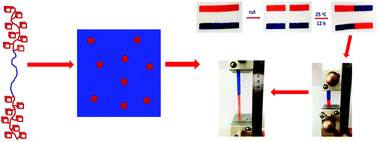Synthesis, self-assembly and self-healing properties of organic–inorganic ABA triblock copolymers with poly(POSS acrylate) endblocks†
Abstract
A novel organic–inorganic ABA triblock copolymer with a poly(acrylate amide) (PAA) midblock and poly(POSS acrylate) [P(POSS)] endblocks was synthesized via sequential reversible addition–fragmentation chain transfer (RAFT) polymerization. The triblock copolymers displayed self-assembly behavior in aqueous solutions; the spherical nanoobjects were formed in aqueous dispersions. Small angle X-ray scattering (SAXS) and transmission electron microscopy (TEM) showed that the triblock copolymers were microphase-separated; the P(POSS) blocks were self-organized into the microdomains dispersed in a PAA matrix. The PAA matrix was significantly reinforced by the P(POSS) microdomains, which was evidenced by the fact that the organic–inorganic triblock copolymers possessed improved thermomechanical properties. In addition, the triblock copolymers can display self-healing properties. It is proposed that in the microphase-separated triblock copolymers, the dynamic exchange of hydrogen bonds in the continuous elastomeric matrix (viz. PAA) is responsible for the rehealable ability whereas the P(POSS) microdomains imparted the improved mechanical properties to the materials.



 Please wait while we load your content...
Please wait while we load your content...